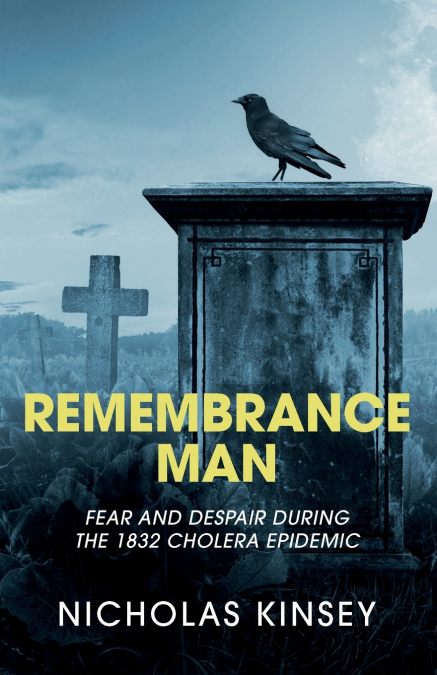
NICHOLAS KINSEY
During the 1832 cholera epidemic, Paolo works for his uncle as a gravedigger in Western Ontario. At night he earns a bonus from wealthy clients as a ’remembrance man’ whose job is to watch over selected graves for signs of the undead. He discovers a young woman who has been buried alive and is drawn into a terrifying story of revenge and insanity.This is a tale of murder, greed and deceit, and the breakdown of society. Family members turn against family members, friends against friends, and soon everyone is out for themselves. Cholera victims are simply abandoned on the roads, and wagons are sent around to collect the bodies and bury them in cholera pits. During these dark days, stories spread about reopening coffins in which the dead had apparently revived after burial, only to die in a futile attempt to escape. No one wanted to bury a loved one who might still be alive, which led to the habit of keeping corpses around so that the families could be sure the person had really died.Cholera had many nicknames, ’King Cholera’ and ’the Blue Death’, due to the bluish pallor of its victims. It caused more deaths than any other disease in the 19th century. It swept through the cities of Europe claiming the lives of 6,500 people in London and 13,000 in Paris. In Montreal and Quebec City, there were 150 deaths and 100 deaths respectively per day in June 1832. People were deathly afraid of cholera as it made its way west up the St. Lawrence River and fear spread faster than the disease itself.'A great read,' Ainsley MacLellan, CBC Radio Producer 'All in a Weekend''Just finished reading ’Remembrance Man’ and I was completely blown away by this compelling and extraordinarily crafted fictional novel. The author skillfully draws upon historical facts surrounding the worldwide cholera epidemic in the mid-nineteenth century, to create a thrilling and intense crime story, the kind that gets under your skin and stirs your whole being. Set against a stark Canadian prairie landscape in the summer of 1832, the deathly dark days of the blue plague are strikingly brought to life in this ambitious tale of inquietude and murder. Visions of abandoned corpses left in the streets, unsanitary conditions, estate manors, other types of dwellings and graveyard settings are evocative and masterfully depicted. The vivid imagery which is fraught with words descriptive of the characters, rich and poor, their behaviour, attire, traditions, religious revivals, poems and songs prevalent at the time, make the storyline meaningful and interesting. There isn’t a dull moment throughout the book.' Vivienne Gaudet, Quebec'I really enjoyed the book. It was informative, as well as entertaining. I was invested in the story and in the fate of the Remembrance Man, Paolo, and his love interest, Emily. Also, because of the way the author wrote about additional characters I was in it for them, too. Even with several characters mentioned throughout the book they were easy to keep up with. This was a can’t put down book for me and I finished it quickly. If you enjoy historical fiction, a twinge of romance, and some mystery and justice pick up this book and give it a read.' BookSirens'The novel is a fast-paced story. I read it in one sitting, and I am not a fast reader. Although I had an inkling that Emily and Paolo would survive and emerge as lovers, their path toward a ’happy ending’ is not an easy one. The inclusion of a pair of beautiful twins adds another twist of irony, as does the fact that Paolo is accused of being a murderer and has to flee for his life in order to avoid being executed. Another item which I found interesting was the ’camp meeting’ of troubled women who find relief through religion under the influence of a fraudulent and predatory preacher. I enjoyed reading the book.' James Hamilton, Sainte-Anne-du-bout-de-l’île Historical Society